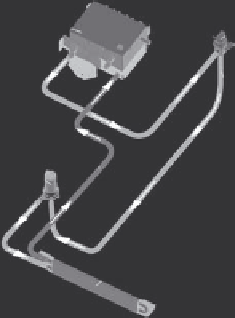Environmental Engineering Reference
In-Depth Information
the present time thermal design and thermal management remain the most sig-
nificant barriers to power electronic reliability. Nearly all vehicle installations of
power electronics for traction and electrification of ancillaries rely on liquid cool-
ing systems such as shown in Figure 4.57.
Inverter liquid cooling system
ISG
inverter
Coolant reservoir
for inverter
Coolant out
to radiator
Coolant into
inverter
12 V coolant pump
for inverter
Heat exchanger
for inverter
Figure 4.57 Thermal management supporting power electronic systems
Notable exceptions are novel two phase, or boiling pool, cooling systems that
rely on complete immersion of the power chips in an evaporative bath. The process
is essentially that of a heat pipe in concept, which means that orientation, chance of
leaks and limited operational strategy are severely impacted by loss of coolant.
Durable, hermetic sealing is absolutely essential. Dumping the waste heat to
ambient also requires fragile plumbing and secondary condensers at the vehicle
radiator zone, contributing to further under-hood heating.
4.7.5 Human-machine interface
Production vehicle clusters, or instrument panels as many customers prefer to call
them, are used to display standard vehicle functions such as speed and engine rpm,
along with indications of battery status, coolant temperature and oil sump tempera-
ture. Figure 4.58 illustrates one technique used to make the instrument cluster, the
HMI, more interactive with the customer by showcasing the hybrid functionality of
an HEV by putting special emphasis on the battery system.
The HV cluster shown in Figure 4.58 has two unique gauges - an energy
available gauge and an electric power charge/assist gauge - plus the necessary
warning lamps to alert the operator of hybrid functional failure. In addition, there
are two display or message centres that provide operational status along with
warning messages about various system functions. Gear shift position in a pro-
duction vehicle is displayed using mechanical linkages, whereas in a hybrid vehicle
this information is in electronic display format on the HV cluster. The panel

















